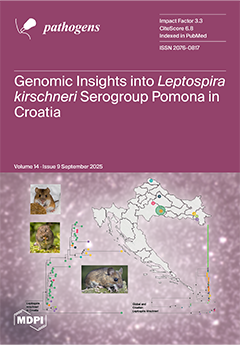The sea cucumber (
Apostichopus japonicus) is a commercially important marine species. However, its survival is increasingly threatened by frequent outbreaks of Skin Ulceration Syndrome caused by
Vibrio splendidus. This study evaluated the effects of dietary supplementation with ferrous sulfate (FeSO
4) at two concentrations (0.5% and 1%) over short-term (21 days) and long-term (56 days) feeding periods on immune defense, antioxidant capacity, and resistance to
V. splendidus infection. Key parameters measured included survival rate, cellular immune activity, antioxidant enzyme levels, and expression of immune-related genes. Long-term (56 days) supplementation with 1% FeSO
4 significantly improved survival after infection (90 ± 4.7%). Phagocytic activity and respiratory burst were enhanced by approximately ~1.9-fold and ~1.8-fold, respectively (
p < 0.05). The expression of
sod,
ferritin, and
hsp70 genes was upregulated by ~2.1-fold, ~2.0-fold, and ~1.6-fold, respectively (
p < 0.05). These results indicate strengthened cellular immunity and antioxidant capacity. Long-term (56 days) supplementation with 0.5% FeSO
4 increased lysozyme activity (~1.3-fold) and
c3 expression (~4-fold) (
p < 0.05), thereby enhancing humoral immunity. In contrast, short-term (21 days) supplementation increased ACP and AKP activities by approximately ~2-fold each, and LZM activity by ~1.2-fold (
p < 0.05). However, it did not significantly improve survival, indicating limited protective effects. Overall, 56-day dietary supplementation with FeSO
4, particularly at 1%, effectively enhances immune and antioxidant responses in
A. japonicus. This supplementation represents a promising strategy for preventing
V. splendidus-induced skin ulceration in aquaculture.
Full article






